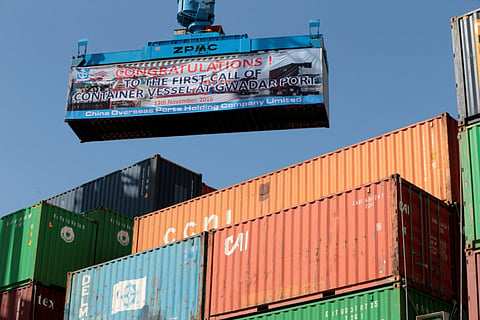In defence of the China-Pakistan Economic Corridor
Islamabad has to launch a series of reforms to increase the potential of the project, and that in turn will help make it financially feasible

The impending arrival of a high-powered Saudi investor delegation to Islamabad tomorrow has been preceded by widespread publicity over a fresh boost to the future of the China-Pakistan Economic Corridor (CPEC). Widely dubbed as a game changer for the future of Pakistan, Saudi Arabia’s entry to this landmark venture could qualify as welcome news, especially if it sets a precedent for investors from other countries.
Initially put together by Pakistan and China, Saudi Arabia’s entry as an investor in CPEC marks the first commitment by a third country to the project. The corridor, which is valued at $62 billion (Dh228 billion) fundamentally aims to connect western China with Pakistan’s southern coastal city of Gwadar through a range of links, notably highways, high-speed train tracks, oil-and-gas pipelines.
A new CPEC map across Pakistan has also been dotted with proposed locations for new electricity generation projects to help tackle the continuing power shortages in the country. These initiatives are planned to form the backbone of a new network of businesses and industries that are meant to boost exports from the region surrounding CPEC for global markets. Once completed, CPEC will link western China — a region far from a coastline — to Pakistan’s Gwadar port and facilitate the free flow of goods to and from the Middle East and other nearby regions
On paper at least, the CPEC plan looks like a great initiative for the transformation of the lives of a large number of Pakistanis who will inevitably find work-related opportunities once the corridor is completed. Yet, in the excitement surrounding the biggest investment destined for Pakistan in the country’s 71-year history, it’s too easy to lose track of a much-needed reality check. Before reaching the outcome of CPEC, Pakistan will have to make a series of major changes in the way the country is governed.
To begin with, Pakistanis must learn to appreciate that just as there is no free meal, likewise, the $62b project will indeed come with a price tag for the common man. For too long, Pakistani leaders, notably under the regime of former prime minister Nawaz Sharif, have left the public with the distinct impression that CPEC-related investments will not be coupled with a heavy price for the country’s mainstream population. In other words, the public message has seldom emphasised the price that will fall upon ordinary Pakistanis in seeing this major initiative reach fruition.
Already, the prospect of CPEC-related payments has begun to overwhelm many knowledgeable Pakistanis who are rather sceptical about the country’s increasingly stressed financial capacity. Pakistanis will have to brace for major increases in their future liabilities. In a country where far too few people pay income tax, this could involve painful times involving either a sharp increase in Pakistan’s national debt and/or tough and long overdue reforms to lift over tax collections.
While the financial aspect of CPEC must be central to any discussion, the question of a visible lack of transparency surrounding this initiative is vital too. In the past five years since CPEC was launched amid much fanfare, the government under Sharif did little in response to criticism over an all too visible lack of information on the finer details of projects under different sectors. This gap further contributed to sharpening the internal political divide, with politicians from different regions lamenting how they were left at a disadvantage as opposed to others.
Perhaps the key to making CPEC a real success story will be to demonstrate how this initiative will lead to a major economic transformation for Pakistan’s mainstream population. Across the world, there are many examples of large infrastructure projects that eventually stood out as white elephants with major liability for the countries concerned. In the absence of a viable economic model, there is always the danger of large-scale infrastructure related expenditure turning out to be more of a liability than a success.
Specific to Pakistan’s case, the recently-elected government of Prime Minister Imran Khan has now shed light on investments on urban transport projects such as the Metro bus services, undertaken in parts of the populous Punjab province under Sharif’s tenure. These involved building elevated speedways on congested roads for driving air-conditioned luxury buses for public transport. Though grand, this project to date appears to have failed to become financially self-reliant. For the foreseeable future, these bus services will have to be subsidised through government grants if they were to remain in service.
Beyond these very challenging questions, policymakers must stay the course in pursuing CPEC as a national objective of top priority. But in doing so, they must vigorously pursue the twin goals of ensuring transparency on CPEC across the board while also making certain that the project remains financially feasible.
Beyond the arrival of Saudi investors, it is vital that Pakistan must seek investments from other friendly countries to ensure that CPEC becomes truly multinational. At the same time, the mistakes of the past linked to this initiative could well qualify as a textbook case on how not to pursue such ventures. It’s time for Pakistan to kick-off a series of reforms to raise the potential of CPEC well beyond lip service by the country’s leaders.
Farhan Bokhari is a Pakistan-based commentator who writes on political and economic matters.
Sign up for the Daily Briefing
Get the latest news and updates straight to your inbox


